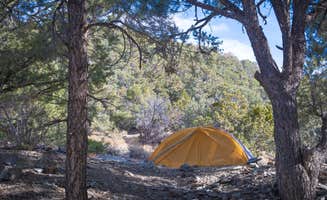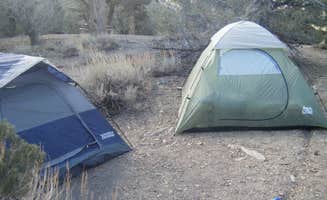Primitive campsites near Amargosa Valley, Nevada offer secluded desert camping at elevations ranging from 2,000 to 8,000 feet. Temperature variations can exceed 40°F between valley floor locations and higher mountain sites. Most primitive camping areas require high-clearance vehicles to navigate unpaved access roads that can deteriorate rapidly after rain events.
What to do
Dark sky stargazing: At The Wild Mustang, campers can experience exceptional nighttime astronomy. "You really feel like you're in the middle of nowhere, in the best way... at night the stars lit up the sky—some of the clearest you will ever see," reports Nate F.
Wildlife viewing: The area supports desert wildlife including coyotes and wild burros. At Summit Well Road, camper Carter G. advises, "It is coyote country and wild donkey country too lol, so be careful at night."
Mountain hiking: For cooler temperatures and challenging trails, head to the higher elevations. "The peak hike was a nice mix of challenging and breathtaking terrain... Bring a bunch of extra water and take it slow on the way up," suggests Tucker B. about Telescope Peak from Mahogany Flat.
Stream exploration: Some remote canyons feature small water sources even in this desert environment. "As you go farther you'll see water and sun. Sometimes you can go down there with a bathing suit if it's hot enough and you can swim in those little ponds," notes Lillyen M. about Carpenter Canyon.
What campers like
Elevation escapes: Higher elevation campgrounds provide relief from summer heat. At Mahogany Flat Primitive Campground, campers appreciate the dramatic temperature difference. "Would have given the site a 5 but our spot had a lot of bees, thankfully they all disappeared once the sun started going down," notes Bryan W., who used the site to escape valley heat.
Easy Death Valley access: Tent camping near Amargosa Valley provides convenient basecamp options. "This is a free campsite for tents only... This is a 10 minute drive from Stove Pipe Wells (just SW of Stove Pipe) & you can get gas as well as general store stuff there," explains Jason E. about camping options.
Privacy between sites: Many primitive camping areas offer good spacing between campsites. At Mack's Canyon Dispersed Camping, Ryan F. notes, "The sites themselves are quite spacious, which is a big plus if you're setting up multiple tents or bringing along larger vehicles and gear."
Natural water sources: Some remote camping areas feature rare desert springs. "There are two little springs that seep out of the ground. I just love how quiet it is you get about a handful of people that come up to see the flowers that are near the spring," describes Patricia L. about primitive camping options.
What you should know
Vehicle requirements: Many camping areas require appropriate vehicles. At Carpenter Canyon, Christie warns: "I was FREAKED out on the way in. 12 miles down a very rocky dirt road. Ripped one of the side steps off the truck. High clearance is a must."
Tent anchoring challenges: The desert terrain makes securing tents difficult. According to Niko L. at Emigrant Campground, "Site can get VERY windy. Take care of your stuff. I've saved multiple tents here that weren't properly secured while their owners were out for the day."
Water availability changes seasonally: Water sources can be unreliable. "Water is not potable year round, will be deemed not potable and/or shut off mid-May per convo with NPS employee. Fill at Stovepipe, Panamint, or elsewhere in summer," notes Niko L. about camping facilities.
Campsite competition: Free sites fill quickly. "I would advise you come early & get a spot. Many people arrived just before sunset & after dark but were not able to get a spot because this filled up so quickly," states a camper about popular tent camping spots.
Tips for camping with families
Pack for extreme temperature swings: Temperature variations between day and night can be severe. One reviewer noted about Mahogany Flat, "It was FREEZING when we went. Lets just say I was not prepared for how cold it was going to be. It got down to 12°F."
Secure site early: For established campgrounds, arrive before mid-afternoon. "Took the travel trailer up Carpenter Canyon on a whim, since we did have a trailer with us we couldn't get all the way to the stream. Ended up pulling off the side of the road, very secluded with a lovely view," advises Cresta P.
Plan alternative activities: If hiking becomes too hot, look for water features. Lillyen M. shares about Carpenter Canyon: "As you get farther into the canyon, it got bumper and I got stuck once but once you got in, it was beautiful as you go farther you'll see water and sun."
Consider noise levels: Roadside camping areas can experience traffic noise. Erik J. notes about convenient Emigrant Campground, "The site is well kept. Trash can we're changed regularly. The restrooms are close and well kept. There is water as well," but mentions its proximity to the road.
Tips from RVers
Camp outside Death Valley with pets: For RVers with animals, Bob M. recommends Summit Well Road: "Good open spaces. There is some garbage but overall good spots to stay when visiting Death Valley for dog owners."
Charging options: Some sites provide electricity access despite being primitive. Mario D. notes that DeathValley Camp "includes a composting toilet & picnic table. You are also welcome to plug in to a standard outlet for charging and use their hose for drinking water and filling tanks."
Road condition awareness: Even improved roads can challenge RVs. "Small campground, but cozy. Drop toilet close by that doesn't get serviced too often because of location," notes Brittany N. about road access to higher elevation camping areas.
Early arrival strategy: Tent camping near Amargosa Valley can fill quickly. Kate confirms this stating, "no one else was there when we arrived later in the evening though we only camped for one night at the end of summer. no one else ever showed up either."





